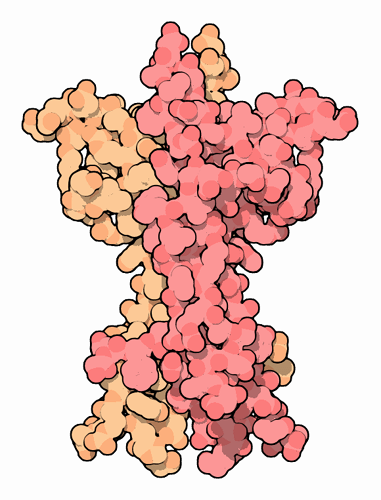|
Inhaltsübersicht | Nanomaschinen | Moleküle | Programme | Kurse | Fun | Links |
||
| > |
Neurotrophins

Neurotrophins
Your brain is composed of 85 billion interconnected neurons. Individually, each neuron receives signals from its many neighbors, and based on these signals, decides whether to dispatch its own signal to other nerve cells. Together, the combined action of all of these neurons allows us to sense the surrounding world, think about what we see, and make appropriate actions.Remarkably, this complicated structure is formed in nine short months as an embryo grows into a baby. Nerve cells start as typical, compact cells, but then they send out long axons and dendrites, connecting to other cells in the brain or even to entirely different parts of the body. Neurons in the growing brain test the connections with their neighbors, looking for the proper wiring. Half of the neurons are discarded during this process, in areas that get too crowded. The half that remain become the nervous system. Throughout the rest of life, these neurons typically do not reproduce, although they do send out more dendrites to neighboring cells as the nervous system grows or repairs damaged areas.
Life or Death Decisions
During this process of nerve development, neurotrophins help nerve cells decide if they are going to live or die. Neurotrophins are small proteins secreted in the nervous system. A steady low level of a neurotrophin is needed to keep nerve cells alive. However, in certain contexts, presence of a neurotrophin can have the opposite effect, initiating the controlled death of the cell. During development of the nervous system, the local levels of neurotrophins control the pruning of unwanted nerve cells. Later in life, neurotrophins are used to stimulate the growth of new dendrites into areas that need them, and to cause unwanted dendrites to die back from crowded areas.Types of Neurotrophins
Four types of neurotrophins have been discovered: nerve growth factor, shown here from PDB entry 1bet, brain-derived growth factor, neutrotrophin 3 and neurotrophin 4. They each have slightly different properties, acting differently on their particular range of nerve cells. All have a similar structure, composed of two identical chains, so similar that in some cases, one can substitute for the other.Neurotrophins in Disease and Medicine
A number of debilitating diseases, such as Alzheimer's disease, stroke, and cancer, may cause neural damage in part through the misfunction of neurotrophins. A current therapeutic strategy to fight these problems is to add neurotrophins to help control any loss of nerve function. Unfortunately, neurotrophins do not last very long in the body when used as drugs and they show significant side effects. So now, researchers are looking for drugs that fool cells into thinking that they are receiving signals from neurotrophins.Next: Neurotrophin Receptors
Last changed by: A.Honegger,